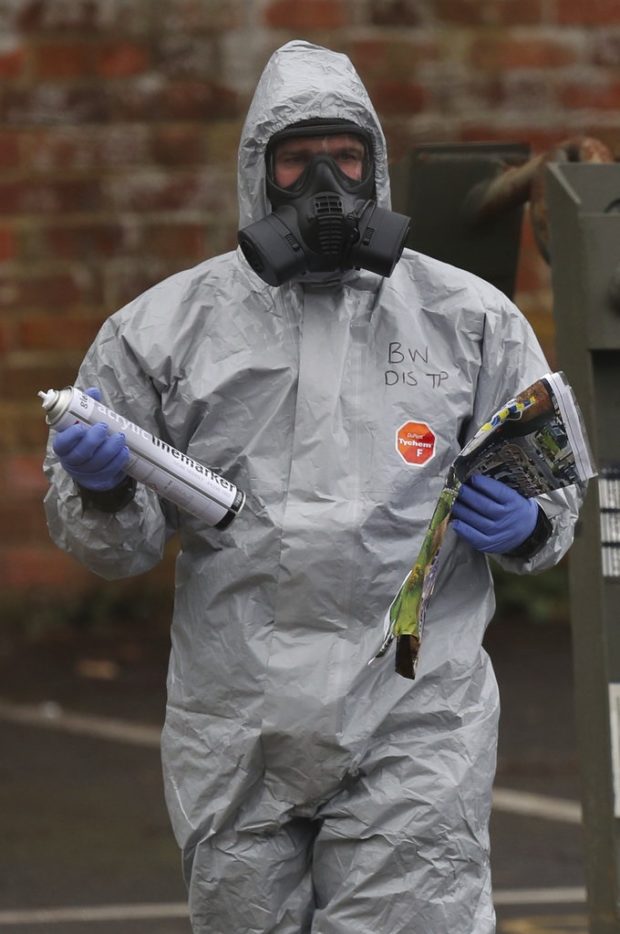Former spy poisoned with Soviet-developed nerve-agent – UK

Military personnel in College Street Car Park in Salisbury on Sunday March 11, 2018, as police and members of the armed forces probe the suspected nerve-agent attack on Russian double agent Sergei Skripal, which took place on Sunday March 4. British health authorities said Sunday that small traces of contamination have been found in a restaurant and a pub in the English city of Salisbury, after a Russian ex-spy and his daughter were poisoned with a nerve agent. (Andrew Matthews/PA via AP)
LONDON — The use of Russian-developed nerve agent Novichok to poison ex-spy Sergei Skripal and his daughter makes it “highly likely” that Russia was involved, British Prime Minister Theresa May said on Monday.
Novichok refers to a class of nerve-agents developed in the Soviet Union near the end of the Cold War. The agents were ostensibly created in an attempt to avoid the international chemical weapons treaty that had just been signed; any new substances would not be subject to past treaties.
Novichok behaves slightly differently than other nerve-agents, with some reports indicate the class of substances is deadlier than similar chemicals like sarin or VX, and harder to identify.
“Novichok agents significantly extend the range of possibility for nerve-agents,” said Andrea Sella, a professor of inorganic chemistry at University College London. There are five known nerve-agents, which are mostly colorless liquids that can kill within minutes, if ingested.
Article continues after this advertisement“With Novichok, you have the potential for a slower-release agent, which gives you much more control,” Sella said. “Using Novichok makes it pretty clear that it was likely Russia that was behind this.”
Article continues after this advertisementGary Stephens, a pharmacology expert at the University of Reading, noted that the component ingredients of Novichok nerve-agents are not on the banned list.
“It means the chemicals that are mixed to create it are much easier to deliver with no risk to the health of the courier,” he said.
Nerve-agents are typically inhaled or absorbed through the skin. They work by blocking a key enzyme that controls communication between nerve cells and muscles — inhibiting the enzyme causes muscles and glands to be overstimulated. That results in symptoms including contracted pupils, vomiting, breathing difficulties, and convulsing muscles.
While the raw materials needed to make a nerve-agent are cheap and relatively accessible, transforming them into a deadly weapon requires specialized expertise, and the kind of safety precautions normally only found in government laboratories.
But trained chemists with access to secure facilities would theoretically be able to produce nerve-agents, which have been described by some scientists as the most deadly invention humans have ever made, after the atom bomb.
“With these kinds of substances, they are just so dangerous that no fly-by-night terrorist group is going to cook this up,” Sella said. “It really smells like a government outfit.”
He added, however, nations other than Russia would also be capable of producing Novichok.
Alastair Hay, a professor emeritus of environmental toxicology at the University of Leeds, said it was possible the food of Skripal and his daughter, Yulia, was contaminated or the nerve-agent was absorbed through the skin, which could take an hour or longer if the substance was administered using something similar to a nicotine patch.
People attacked with Novichok can potentially be treated with compounds called oxines, but recovery would depend on how quickly doctors are able to pinpoint the right compound, according to Hay.
Since nerve-agents affect the respiratory center in the brain and reduces the amount of oxygen in the body, the primary worry for people exposed to nerve-agents is brain damage, Hay said.
“All of the evidence is that for people who are this severely poisoned, is that a full recovery is far from guaranteed, and they may have residual problems as a result of damage to the brain,” Hay noted.
Scientists will likely be analyzing any trace amounts left of the Novichok to determine which laboratory might have produced it.
Experts said any remaining bits of the substances used to make the nerve-agent or impurities left by the chemical reaction used in the manufacturing process could be revealing.
“Those might give you a clue where it was made,” Hay said. “Intelligence agencies and governments have a reasonable idea about the different processes that have been used and which countries use specific methods of manufacturing.”
Still, he said, this was not an exact science and that police would have to gather evidence beyond the laboratory to narrow down where the nerve-agent originated.
Any samples of the Novichok left in the environment could also be useful as police construct a timeline of the attack — analyzing where the agent was left in the highest concentrations will help determine where Skripal, his daughter, and the police officer, who first responded to the incident, were exposed.
Hay said that among crime’s biggest mysteries is why the perpetrators even chose to use Novichok.
“If you wanted to kill someone, there are much more effective ways to do this than to go to these lengths with something that’s so identifiable,” he said. “But maybe that’s part of the message.”
“Maybe this is just somebody saying, ‘we don’t care if you identify us as the attackers and we don’t care if you know’,” he also said. /kga